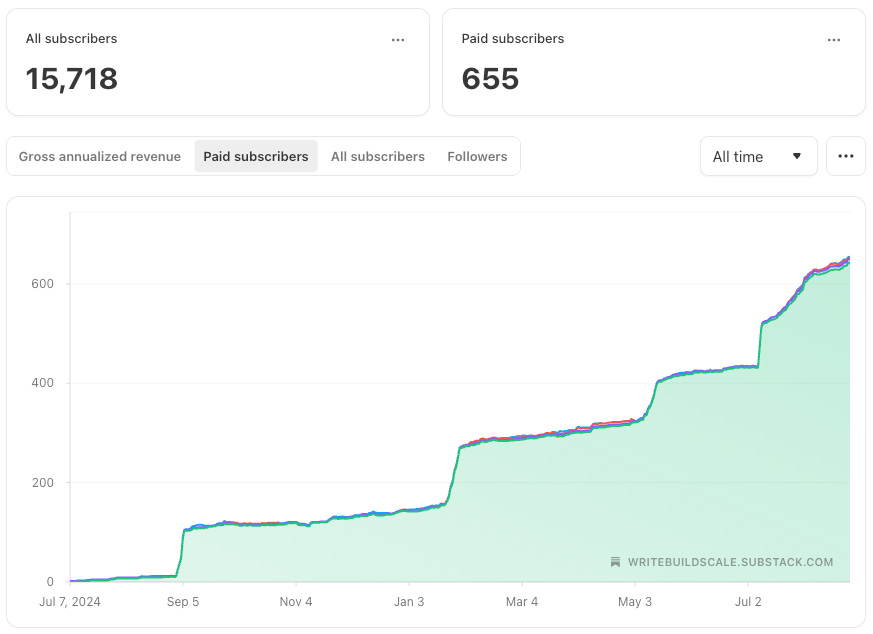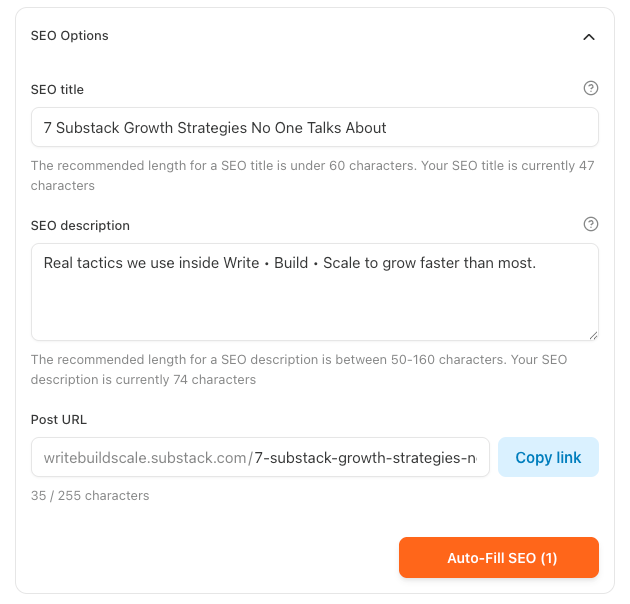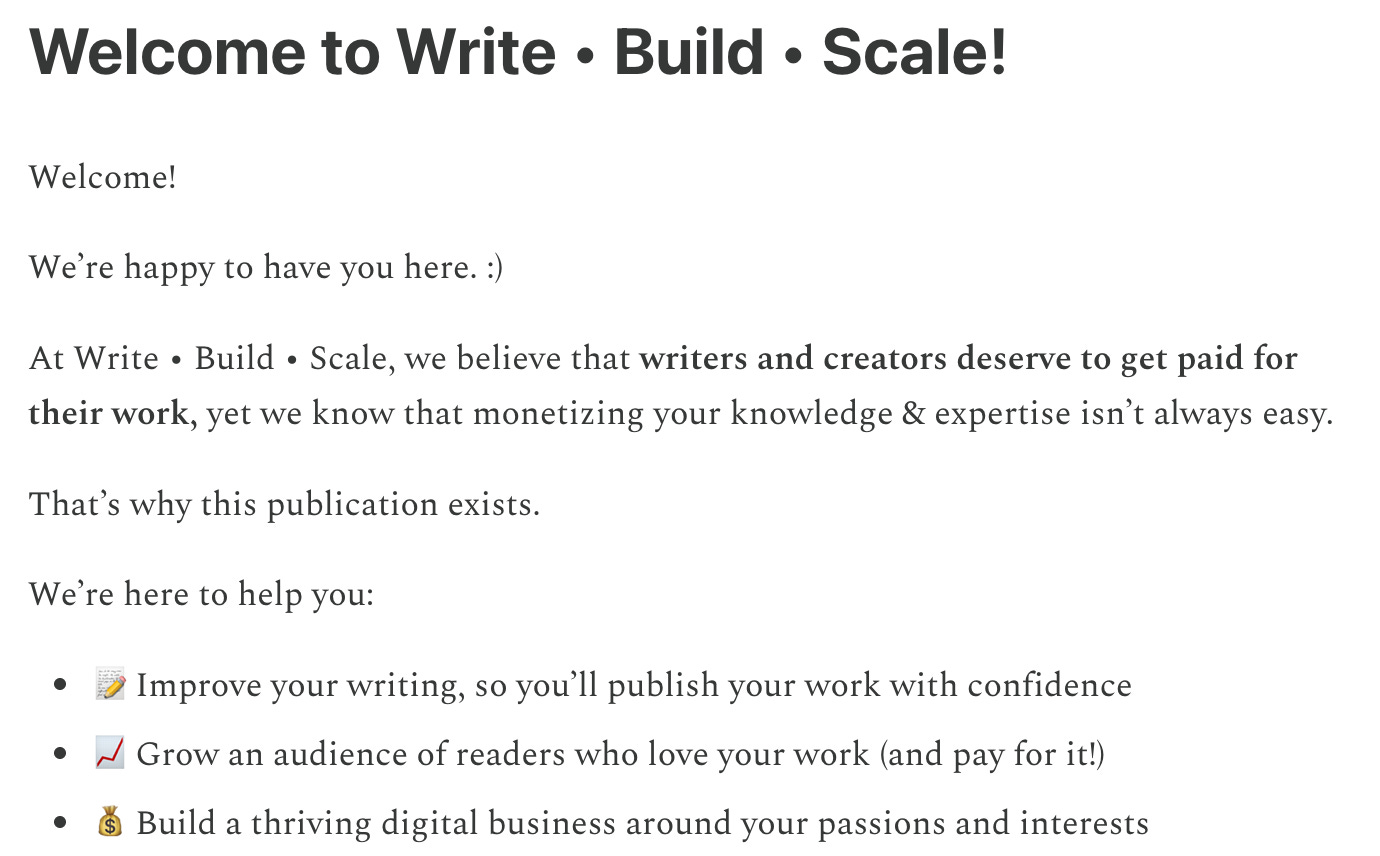The Truth About Substack Growth
We tested the obvious tactics and much more.
Everyone talks about posting more, writing better headlines, or collaborating with other writers to grow on Substack.
And while those are effective strategies, they’re also the ones everyone already knows.
In this post, I’m going to show you other strategies: the ones most creators overlook, even though they can make a massive difference to your growth on Substack.
These are the exact tactics we’ve tested inside Write • Build • Scale to gain 650+ paid subscribers within a year, and some of them are hiding in plain sight, right inside your Substack dashboard.
If you stick with me until the end, you’ll walk away with a list of growth ideas your competitors probably have never even thought about.
Why these strategies work so well
Before we dive into the tactics, let’s talk about why these lesser-known strategies are so powerful: When you only use the same growth tactics everyone else is using, you’re competing for the same attention in the same way.
When you start leveraging the hidden features and underused tools on Substack, you instantly stand out. You tap into opportunities most creators never even touch.
That means more visibility, faster growth, and stronger relationships with your readers.
Let’s dive in!
1. The VIP Reader Outreach
Inside your Substack dashboard, you can see who your most engaged readers are.
These are the ones who open most of your emails, click most links, and often engage with your work. Most creators completely ignore this data.
But these are essentially your superfans.
They’re your most important audience members.
Since you have access to this information, you can turn that into an advantage by contacting these readers directly.
You can use this opportunity to just thank them for their support and make a special offer, oryou can even ask for feedback or invite them to support your next initiative.
Since these are your most loyal readers, they’re familiar with your work and invested in your publication, which means they’re likely to respond and convert if you make an offer.
Here’s how you find your VIP readers:
Go to your publication Dashboard and to “Subscribers” (under “Audience”)
Click on “Filter” and select “Activity”
Now you can choose between “None” or 1-5 stars
You can also select multiple options here. For instance, I could pick all of my 4- and 5-star readers if I want to contact a bigger pool of subscribers:
Once you’ve set the filters, you can select the fitting subscribers and email them directly:
Here’s a specific example of how we’ve used this strategy in our own promotion:
2. Treat Recommendations as a Warm Introduction Engine
Most creators treat recommendations as a static list. They add a few partners to their Substack recommendations once and forget about it.
Instead, treat it as a dynamic, rotating warm introduction system.
Here’s how it works:
Every month, look at your analytics and identify which recommendations are sending you the most subscribers.
Then send those creators a personal message. Ideally, with a very specific ask to deepen the relationship and create a win-win situation.
Invite them to co-create something.
Collaborate on a post, swap guest articles, or host a joint Q&A session.
This matters because a reader who finds you through a recommendation is far more likely to become a loyal or paying subscriber if they also see you in that creator’s feed or email.
It’s like a double endorsement that builds more trust.
You can also consider rotating your recommendation partners every 30-60 days to keep things fresh and create more of these warm introductions.
This turns recommendations from a passive list into an active, compounding referral engine.
And you’re also building strong creator relationships in the process.
3. Use Substack’s Built-In SEO Options
One of the most underrated Substack features is how well your posts can rank in Google.
Most people only write for their email subscribers, but if you structure posts for search, you can attract an entirely new audience that is actively looking for the solutions you provide through your work.
We’ve had posts bring in new subscribers every week, months after publishing — just because we optimized them for search.
At the very least, you can go into your SEO options and let ChatGPT help you generate a proper SEO title, description, and post URL for each piece:
This simple step won’t take you more than 5-10 minutes, but it will give you better odds of showing up when people search for the type of content you create.
4. The “Tease & Convert” Paid Strategy
Most people just use Substack’s basic paywall to lock content.
They give away a small part of an article for free and force readers to upgrade to read the rest.
But what we’ve seen work much better is when the locked content is not just the rest of a piece but a valuable bonus.
For example, we might give away the entire article for free, but we include a bonus behind the paywall, like:
A worksheet
A detailed AI prompt
A swipe file
A bonus template
This way, you prove that your free content is valuable, but you give your free readers a strong incentive to still upgrade.
Here are two examples where we’ve used this specific strategy in our paid posts:
5. Comment-to-Content Conversion
One of the richest sources of growth ideas sits right under your own posts and Notes: your comment section.
When a reader asks a thoughtful question or shares a great perspective, highlight it in your next piece. Tag them in your next post. Respond publicly.
This creates highly relevant content, makes your readers feel seen, and boosts engagement.
Plus, you never run out of ideas!
6. Personalized Welcome Emails
When someone subscribes to your publication on Substack, they automatically receive a welcome email.
What most creators don’t know is that this is the most-opened email you send, so it’s an incredibly valuable asset.
Your welcome email is an opportunity to:
Introduce yourself
Set expectations
Link to your best posts
Add a clear call-to-action
The faster someone connects with your work, the more likely they are to stick around and eventually become a paying member.
Here’s what the first part of our welcome email at Write • Build • Scale looks like:
7. The Surprise Live Session
One of the fastest ways we’ve built loyalty and boosted growth is by hosting surprise live sessions for our subscribers.
We usually announce these sessions just a few days in advance. There’s no sign-up process, and subscribers can easily drop in and out if they want to listen to the conversation.
We keep them casual, interactive, and Q&A-focused so we can actually have a conversation with our audience.
Readers love the spontaneity and unfiltered nature of these sessions.
And as long as you don't hate being on camera, these sessions are incredibly easy to host because you literally just have to talk about the topics you are writing about anyway.
You can even use this to discuss specific pieces that you have recently published. Or invite guests who help you cover a certain topic from a different angle.
To give you a better idea, here’s a collection of live streams we’ve hosted at Write • Build • Scale:
Final Thoughts
You now have a library of seven Substack growth strategies that most people never talk about or even use.
If you start applying just two or three of them, you’ll put yourself miles ahead of most creators on the platform.
And if you want more strategies like these plus the exact systems we use to grow Write • Build • Scale, subscribe now:
💰 Next: How much money can you make on Substack?
If you're not sure whether Substack is worth it for you and what you can expect from the platform, check out this video where I explain exactly how you can make money on Substack and what it takes to make a significant income on the platform:












Wow—this is gold. Thank you for laying out such a clear, actionable roadmap. I’m especially excited to test the VIP Reader Outreach and rotating recommendations. The reminder that hidden features = hidden growth is the nudge I needed. 🙌
Ideas are terrific. But what happens when everybody’s using them?